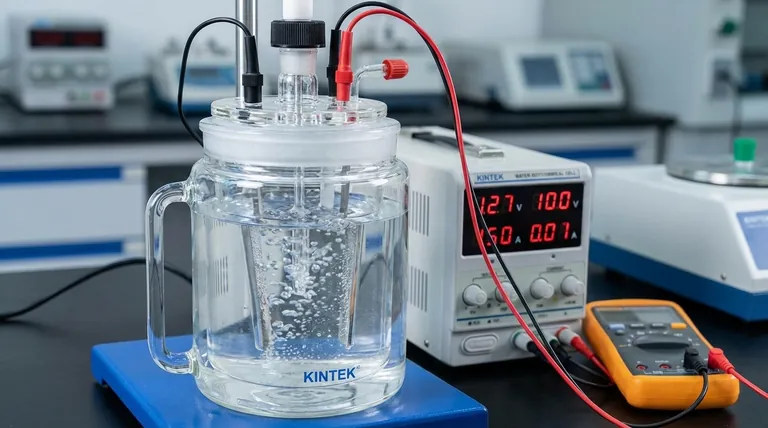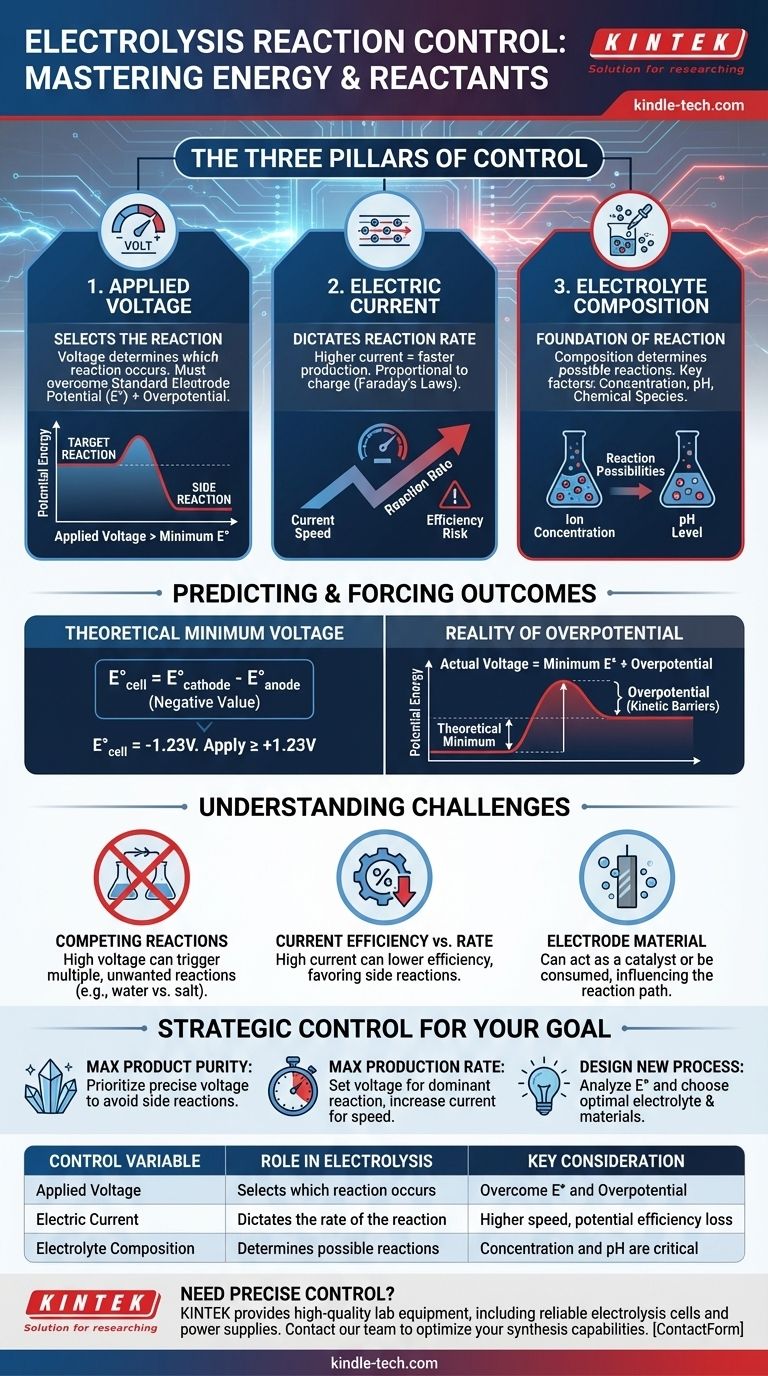At its core, controlling an electrolysis reaction is about managing the flow of energy and the availability of reactants. You can precisely dictate the chemical outcome by carefully adjusting three key variables: the applied voltage, the electrical current, and the chemical composition of the electrolyte solution.
Electrolysis is the process of using electrical energy to force a non-spontaneous chemical reaction to occur. Control is achieved by understanding that voltage selects which reaction happens, while current dictates how fast it happens.

The Three Pillars of Electrolytic Control
To master electrolysis, you must treat it not as a single process, but as a system governed by distinct, yet interconnected, factors.
Applied Voltage: The Selector of the Reaction
The applied voltage is the most critical factor for determining the specific chemical reaction that occurs. Every possible reaction at the anode (oxidation) and cathode (reduction) has a theoretical minimum voltage at which it can proceed, known as its standard electrode potential.
By carefully setting the voltage across the cell, you provide just enough energy to initiate your desired reaction while withholding the energy needed for unwanted side reactions to begin.
Current: The Accelerator of the Reaction
The electric current, measured in amperes, represents the flow of electrons through the system. According to Faraday's laws of electrolysis, the amount of product formed is directly proportional to the total charge (current multiplied by time) passed through the cell.
Therefore, once you have selected your desired reaction with the correct voltage, you can control the rate of production by increasing or decreasing the current. A higher current means a faster reaction.
Electrolyte Composition: The Foundation of the Reaction
The electrolyte is the source of the ions that will be oxidized and reduced. Its composition dictates which reactions are even possible.
Changing the concentration of the target ions, adjusting the pH, or adding or removing other chemical species can fundamentally alter the cell's behavior and the voltages required for different reactions.
Predicting and Forcing the Outcome
You can predict the minimum energy required for a reaction by analyzing the standard potentials of the possible half-reactions.
Using Standard Electrode Potentials
Tables of standard electrode potentials (E°) list the voltage of various reduction half-reactions relative to a standard reference. These values are the key to predicting electrolytic behavior.
For an electrolytic cell, you are forcing a reaction that would not happen on its own (it has a negative overall cell potential). You must apply an external voltage that is at least equal to the magnitude of this negative potential.
Calculating the Minimum Voltage
To find the theoretical minimum voltage, you identify the oxidation and reduction half-reactions you want to force. You calculate the standard cell potential (E°cell = E°cathode - E°anode). For a non-spontaneous reaction, this will be a negative number.
The minimum external voltage you must apply is the absolute value of this negative E°cell. For example, if E°cell is -1.23 V, you must apply at least +1.23 V.
The Reality of Overpotential
In practice, the actual voltage required is always higher than the theoretical calculation. This extra voltage, known as overpotential, is needed to overcome kinetic barriers and resistance within the system, such as at the electrode surfaces.
Understanding the Trade-offs and Limitations
Achieving precise control requires navigating several real-world challenges where variables conflict.
The Problem of Competing Reactions
In many cases, especially in aqueous solutions, your applied voltage may be high enough to trigger multiple reactions. For example, the electrolysis of water to produce hydrogen and oxygen can compete with the electrolysis of dissolved salts if their required potentials are close.
Current Efficiency vs. Reaction Rate
While a higher current increases the reaction rate, pushing it too high can be counterproductive. It can increase the effects of overpotential, favoring less-desirable side reactions and lowering the current efficiency—the percentage of electrons that contribute to the desired product.
The Electrode Material Is Not Always Inert
The material of your anode and cathode can significantly influence the reaction. Some materials act as catalysts, lowering the overpotential for a specific reaction and favoring it over others. In other cases, the electrode itself can be oxidized, becoming an active participant instead of an inert surface.
Making the Right Choice for Your Goal
Your strategy for controlling the cell depends entirely on your desired outcome.
- If your primary focus is product purity: Prioritize precise voltage control to stay above the potential for your target reaction but below the threshold for competing side reactions.
- If your primary focus is production rate: Set the voltage to ensure your reaction is dominant, then increase the current to the maximum level that maintains acceptable current efficiency.
- If your primary focus is designing a new process: Begin by analyzing electrode potentials and choosing an electrolyte composition and electrode material that thermodynamically favors your desired reaction.
By mastering these principles, you transform electrolysis from a brute-force application of power into a precise and predictable tool for chemical synthesis.
Summary Table:
| Control Variable | Role in Electrolysis | Key Consideration |
|---|---|---|
| Applied Voltage | Selects which reaction occurs | Must overcome standard electrode potential and overpotential |
| Electric Current | Dictates the rate of the reaction | Higher current increases speed but can lower efficiency |
| Electrolyte Composition | Determines possible reactions | Concentration and pH are critical factors |
Need precise control over your chemical processes? KINTEK specializes in high-quality lab equipment, including reliable electrolysis cells and power supplies. Our experts can help you select the right tools to master voltage, current, and electrolyte variables for your specific application. Contact our team today to optimize your lab's synthesis and production capabilities!
Visual Guide

Related Products
- Double Layer Five-Port Water Bath Electrolytic Electrochemical Cell
- Optical Water Bath Electrolytic Electrochemical Cell
- Quartz Electrolytic Electrochemical Cell for Electrochemical Experiments
- Double-Layer Water Bath Electrolytic Electrochemical Cell
- H-Type Double-Layer Optical Electrolytic Electrochemical Cell with Water Bath
People Also Ask
- What precautions should be taken regarding temperature control for the electrolytic cell? Ensure Safe & Accurate Electrolysis
- What inspection steps should be performed before using the electrolytic cell? A Guide to Safe & Accurate Experiments
- How should the electrolytic cell be secured on the stand during an experiment? A Step-by-Step Guide for Stability
- What is the applicable temperature range for the electrolytic cell and how is the temperature controlled? Achieve Precise Electrochemical Results
- How should faults with the electrolytic cell be handled? A Guide to Safe Diagnosis and Repair



















